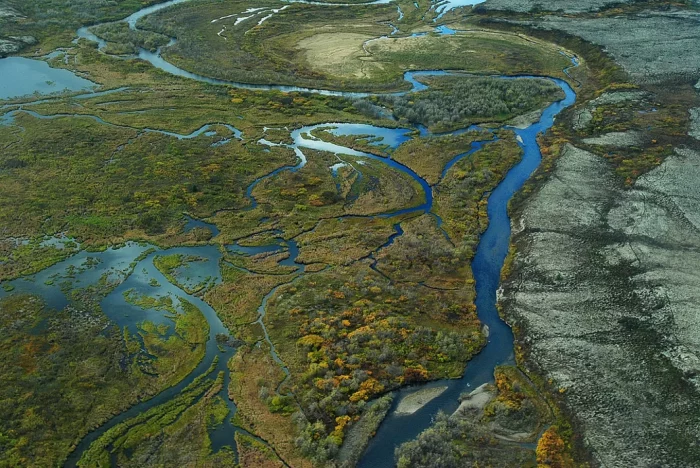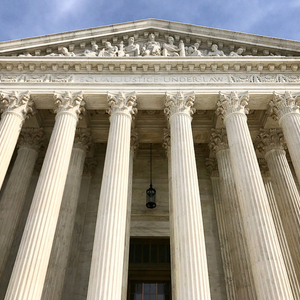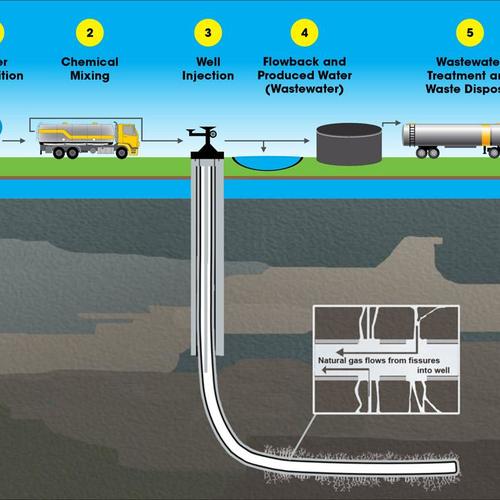
The ruling last month by the U.S. Supreme Court (SCOTUS) in Sackett v. Environmental Protection Agency (EPA) has enormous ramifications for the health of the nation’s waterways. In fact, it wouldn’t be hyperbole to call Sackett the most important water-related Supreme Court decision in a generation. Unfortunately, a majority of the justices used the case as a tool for dramatically weakening the Clean Water Act—by deciding for themselves, without any scientific support whatsoever, what wetlands deserve protection from pollution and destruction.
The background of the case
Michael and Chantell Sackett, who ran an excavation company, sought to develop property a few hundred feet from Priest Lake, a popular vacation site in the Idaho Panhandle, with plans to build a house there. To prepare the lot for construction, the Sacketts began to fill it with gravel. In 2007, responding to a neighbor’s complaint, the EPA halted the work after determining that the Sacketts’ lot contained a federally protected wetland. Under the authority granted to it by the Clean Water Act, the agency ordered the couple to remove the gravel and cease any further construction without a permit. The Sacketts sued in 2008, and the case wound its way through the federal court system for the next 14 years. Among other things, their lawyers argued that the wetland the Sacketts filled was not a protected “water of the United States,” merely because there was dry land between it and other bodies of water—and thus it wasn’t subject to EPA regulation.
What are the ‘waters of the United States’?
Since 1972, the Clean Water Act has played an essential role in protecting the country’s diverse array of aquatic environments from pollution and keeping them safe for fishing, swimming, and wildlife (not to mention as sources of drinking water for millions of people). And for roughly that same amount of time, the act has also been the target of polluters and developers who would like to limit its regulatory scope. One way they’ve attempted to do so? By focusing on a particular—and pivotal—bit of language found in the law, five simple words that carry enormous legal weight: “waters of the United States” (or WOTUS, for short).
Numerous pollution control programs in the Clean Water Act apply only to these protected waters. For most people, defining “waters of the United States” is a pretty straightforward matter: The phrase refers to—or at least seems like it would be referring to—the many different bodies of water to be found within the geographical borders of our nation. And according to Jon Devine, the director of NRDC’s federal water policy team, that’s pretty much the correct way to define it.
“Congress intended the phrase to be interpreted very broadly,” says Devine. When lawmakers were drafting the Clean Water Act half a century ago, he says, they envisioned its protections as extending to all the various bodies of water that make up a watershed, many of which people use for recreation, fishing, and drinking water supply. And while those lawmakers may not have been hydrologists, they nevertheless understood the fundamental interrelatedness of these different bodies of water. “So the very earliest regulations set forth by the EPA were inclusive,” Devine notes. As a jurisdictional matter, WOTUS comprised “all the relevant parts of an aquatic ecosystem, including streams, wetlands, and small ponds—things that aren’t necessarily connected to the tributary system on the surface, but that still bear all kinds of ecological relationships to that system and to one another.”
Still, given the restrictions on how people could interact with these protected waters, interested parties were inclined to litigate the meaning of the term over the decades. “There were always fights about it,” Devine says. “A developer who wanted to bulldoze a wetland, or a polluter who was being prosecuted for dumping into a small stream, would question whether that particular feature should really be considered a water of the United States.” But, as Devine notes, “they largely lost.” And as a result, the more inclusive definition prevailed. Or at least it did until the early 2000s, when cracks in that foundation began to develop—cracks that ultimately led to the Clean Water Act’s rupture at the hands of the current Supreme Court.
SCOTUS on WOTUS
To grasp the importance of the Sackett ruling, it’s important to understand the tension between two past opinions authored by Supreme Court justices Antonin Scalia and Anthony Kennedy in an earlier 2006 case, Rapanos v. United States. Like Sackett v. EPA, it also involved someone filling wetlands without a permit to do so. In their individual opinions, Scalia and Kennedy outlined two contrasting ways of identifying which waters merited protection under the Clean Water Act. For Scalia, those that qualified had to be either so-called navigable waters (think rivers, lakes, basically anything that can accommodate a boat), regularly flowing tributaries to those waters, or wetlands—so long as those wetlands had a continuous surface connection to a body of water that already enjoyed federal protection.
Kennedy saw things differently. He maintained that the connection between wetlands and other bodies of water didn’t necessarily have to be visible—i.e., continuous and on the surface—but could be measured in other ways. For Kennedy, the far more important question was: Does a given wetland share a significant nexus with another, adjacent body of water that’s already protected? Or (in somewhat plainer English), would polluting or destroying certain wetlands affect the physical, chemical, or biological health of the second body of water? If the answer was yes, Kennedy believed, then both deserved the same level of protection.
Although the lower courts consistently ruled that wetlands satisfying Kennedy’s test must be protected (consistent with the views of both the Bush and Obama administrations), polluting industries kept arguing that Scalia’s view should govern. The Trump administration adopted a definition based on the Scalia approach, but it was struck down in court when the Biden administration refused to defend it. Which brings us to Sackett: a case that has effectively turned the tables by solidifying Scalia’s view as the new standard for determining the connectedness of water bodies.
The impact on our wetlands—and our water
Though the court technically ruled unanimously in favor of the Sacketts—all nine justices agreed that the specific wetlands in the case didn’t qualify for protection—the real damage from Sackett is in how the court elaborated on their opinions, which tell a very different story.
Writing for the 5-to-4 majority, Justice Samuel Alito asserted that the late Justice Scalia’s definition of “waters of the United States” was the proper one: any wetland that does not connect at its surface to another body of federally protected water doesn’t merit the same degree of protection. Alito dismissed the significant nexus rule established by the now-retired Justice Kennedy as “particularly implausible.”
As almost any water expert would tell you, Alito’s opinion has no basis in science. Water flows in all sorts of ways: aboveground; belowground; rapidly, down rivers and streams; and also slowly—through the cleansing filters of the reeds, soils, and grasses that make up a wetland. “The notion that the law can’t protect a body of water, simply because there’s a road between it and another body of water that’s unquestionably protected, is absurd and unscientific,” Devine says. “And it would defeat the purpose of the Clean Water Act.” It’d surely come as a surprise to the members of Congress who wrote the law that, as Justice Alito contends, “the CWA does not define the EPA’s jurisdiction based on ecological importance.”
Interestingly, support for the scientifically backed position that wetlands are intrinsically connected to adjacent waterways came from one of the court’s most staunchly conservative justices. Justice Brett Kavanaugh disagreed vociferously with Alito and his other colleagues in the majority. In his opinion, Kavanaugh took issue with “the Court’s rewriting of adjacent to mean adjoining.” This echoed Justice Elena Kagan’s opinion that “in ordinary language, one thing is adjacent to another not only when it is touching, but also when it is nearby. So, for example, one house is adjacent to another even when a stretch of grass and a picket fence separate the two.” Kavanaugh expressed his well-justified concern that this SCOTUS decision may “leave long-regulated and long-accepted-to-be-regulable wetlands suddenly beyond the scope of the agencies’ regulatory authority.”
In the words of one of those agencies, the EPA, wetlands “are among the most productive ecosystems in the world, comparable to rainforests and coral reefs.” By regulating water flow, they dramatically lessen the impact of both floods and droughts. They provide habitat for all manner of fish, birds, mammals, insects, reptiles, and amphibians. And they do all of these things while storing massive amounts of carbon in their abundant vegetation—making safeguarding wetlands a valuable natural climate solution.
Nevertheless, a majority of the Supreme Court has decided that it knows better than scientists, the EPA, and Congress. Our country’s wetlands, the waterways that are intrinsically connected to them, and the people who rely on them will suffer as a result.
Jeff Turrentine is a senior writer at the Natural Resources Defense Council, where this article was originally published.
Weekly Newsletter
Get building science and energy efficiency advice, plus special offers, in your inbox.















16 Comments
It's all so fucking depressing. Being able to say "I told you so" in the near future as ecosystem collapse accelerates will not be much consolation.
Reminds me of this book:
I wholly disagree with this decision
However....
The federal gov't should not really be dealing with essentially local wetlands issues
It is not built for it
This would never happen in Massachusetts or many other states, and therein is the issue.
These cases frequently come out of red states, and honestly, if you lived there, how annoying would it be to have the Feds legislating your issues, because your state refuses to do its job?
So, for a majority of the country, this ruling has little effect. I don't apply for federal permits to build on my swampy property.
It is entirely likely that here in the People's Republic of Mass, I could do what these property owners desired with a simple town con com meeting, and state filing. Probably have to plant a few native bushes.
Eventually these red states will figure out that this ruling is no panacea for them, and pass their own wetlands regulations if only to preserve local control
"It is entirely likely that here in the People's Republic of Mass, I could do what these property owners desired with a simple town con com meeting, and state filing. Probably have to plant a few native bushes"
Nope.
Sorry?
Please do expand.
wetlands issues such as these carry no federal permits here.
Local com coms can very widely as can local regulations, but the state governs.
If the con com decides it is not a problem, is issues a negative determination, or a positive determination, either coming with an order of conditions.
I may disagree with such determinations, but it goes to the Mass DEP on appeal one way or another, perhaps to court.
I have never seen the EPA involved at this level for this kind of thing
Your state agency is acting in coordination with the federal laws. The federal law is not somehow entirely voided just because your state or local municipality handles the permitting process.
Whether or not someone in your state would be allowed to perform the filling as easily as you imply depends on the size of the filling.
You might be surprised at what type of projects are governed by the Clean Water Act. If your wetland is hydrologically connected to a stream and that stream flows into a navigable river, any construction activity that results in soils being washed into the stream subject you to a federal enforcement action.
Before I retired, I represented a site subcontractor who was working on a hillside subdivision. The site was uphill from a little stream that eventually flowed into the Concord River. A torrential rain event resulted in water flowing through the typical erosion barrier and eventually some mud ended up.in the stream.
Even though my client wasn't the developer, he ended up with a fine of almost $100k. The entire problem would have been avoided had he obtained a (free) CWA permit.
The Sackler opinion is troubling because the Court wrote new language into the statute, requiring a surface connection of the water body at issue. That's completely made up.
Ah yes, the old "defer every significant decision to the state" even though the court is inventing their own definitions and watershed ecosystems don't follow state lines. It may not make a big difference, immediately, in states that have robust environmental regulation, but that doesn't mean it's not a decision that will have long-lasting and significant results.
I don’t think this decigen is about what is a wet land and more about limiting the power of unelected unaccountable bureaucrats from pushing vaguely worded laws to the extreme limits.
““Congress intended the phrase to be interpreted very broadly,” says Devine. When lawmakers were drafting the Clean Water Act half a century ago”
I don’t think the congressman who voted for the clean water act thought they were regulating every mud puddle and damp spot in the country. If you think I am wrong write up the clean mud puddle act and see if you can get it enacted. If you want to regulated mud puddles the be specific when you write the law. Seems like Lake Erie had caught on fire when they passed this law and that is what they had in mind.
Walta
Walta. The Court took the language "adjacent" in the statute and decided it can only mean physically connected at the surface.
The EPA is part of the executive branch, which is accountable to the voters every four years. The Court is accountable to no-one, as it has made clear by its refusal to be bound by the same rules that apply to every other federal employee.
" don’t think this decigen is about what is a wet land and more about limiting the power of unelected unaccountable bureaucrats from pushing vaguely worded laws to the extreme limits. "
How ironic, when the Supreme court consists of entirely unelected, unaccountable bureaucrats.
So, the next president is free to fire all the EPA bureaucrats that he disagrees with?
I think not making the bureaucrats unelected unaccountable.
Walta
That's exactly what the last president did.
Who do you think should be responsible for making decisions such as these?
Most employees of federal agencies are protected by Civil Service and can't be fired without cause. Each president can, and does, fire the cabinet officers and sub cabinet people.
The epa actually needs science to justify their positions, which they did not do with trump.
Stop even treating this like there are two sides to this. One side cars about public land and the other only cares about maximizing profit, aka capitalism. And if you are on the side of capitalism/conservatism, why are you here?
Putting aside whether the decision is correct based on the language of the Clean Water Act ("CWA"), it is likely this restrictive ruling on the scope of the CWA will cost us thousands of acres of valuable fresh water resources at a time when lack of potable water is one of the most pressing issues facing much of the country.
It has been a long time since I studied envrironmental law (I skipped the Admin Law course offered at my law school by none other than Antonin Scalia). However, it seems to me that Congress intended the law to have broad application and for the federal regulator s (mainly EPA) to create an extensive regulatory framework to fill in the gaps (complex legislation requires extensive regulations to fill in the blanks, since Congress cannoit draft thousands of pages of technical text into statutes; and this is why those who have negative opinions of government want to dismantle the regulatory machinery as being an unconstitutional delegation of Congressional power ). In drafting the CWA, limits on federal authority needed to be considered which is why the CWA was crafted to reference interconnected navigable waterways.
In any event, I hope we do not go back to the days before the CWA. Many states and localities are just not inclined or equipped to challenge wealthy business interests bent on exploiting natural resources for their own gain. I recall well what happened to my dad in 1970. He had purchased a small home on a cove on a barrier island in NJ. We had 100 ft of sod bank in our back yard, but the other two sides (about 150 feet long) of the three sided cove were bulkheaded. Dad did not own the riparian rights to the cove area, but he did not think anyone could just fill in the cove and tresspass over his property for access. Then one day in the off season, the town started putting in sewers and needed to dispose of the removed sand and soil. Somehow the owner of the riperian rights must have cut a deal with the town and all of a sudden truck after truck began driving across our property dumping the removed soil into the cove...no permit, no bulkhead...nothing!.. By the time my dad got an injunction, the entire cove was filled, the end was bukheaded and the owner was trying to subdivide into 6 lots and an extension of the egress road! The injunction dad finally got lasted for over 30 years- stopping anyone from developing this large vacant lot at the Jersey Shore. But in the mid 2000's the law became more amenable to private property interests and the town and the owner of the lot convinced a judge to lift the injunction to allow a single building lot. My dad was exhausted and the injunction was lifted; soon to be followed by a giant bay front house.
Log in or create an account to post a comment.
Sign up Log in